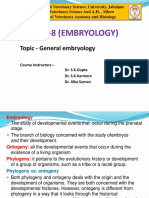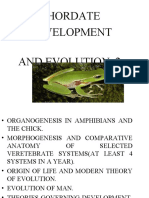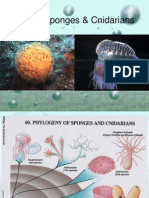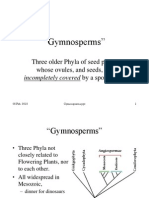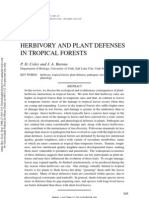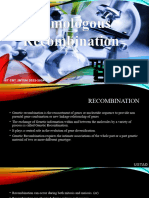100%(1)100% found this document useful (1 vote)
Phylum Chordata
Phylum Chordata
Uploaded by
sehrishThe document discusses the phylum Chordata, which includes about 45,000 species that inhabit both aquatic and terrestrial environments. The four key characteristics of chordates are the presence of a notochord, pharyngeal slits or pouches, a dorsal tubular nerve cord, and a postanal tail at some stage of development. Pharyngeal slits evolved for filter feeding in aquatic chordates but now also aid in respiration with the addition of gills. The nerve cord allows for complex sensory and motor functions and is important for chordate success.
Copyright:
© All Rights Reserved
Available Formats
Download as PDF, TXT or read online from Scribd
Download as pdf or txt
Phylum Chordata
Phylum Chordata
Uploaded by
sehrish100%(1)100% found this document useful (1 vote)
The document discusses the phylum Chordata, which includes about 45,000 species that inhabit both aquatic and terrestrial environments. The four key characteristics of chordates are the presence of a notochord, pharyngeal slits or pouches, a dorsal tubular nerve cord, and a postanal tail at some stage of development. Pharyngeal slits evolved for filter feeding in aquatic chordates but now also aid in respiration with the addition of gills. The nerve cord allows for complex sensory and motor functions and is important for chordate success.
Original Description:
Chordates
Original Title
phylum Chordata
Copyright
© © All Rights Reserved
Available Formats
PDF, TXT or read online from Scribd
Share this document
Did you find this document useful?
Is this content inappropriate?
The document discusses the phylum Chordata, which includes about 45,000 species that inhabit both aquatic and terrestrial environments. The four key characteristics of chordates are the presence of a notochord, pharyngeal slits or pouches, a dorsal tubular nerve cord, and a postanal tail at some stage of development. Pharyngeal slits evolved for filter feeding in aquatic chordates but now also aid in respiration with the addition of gills. The nerve cord allows for complex sensory and motor functions and is important for chordate success.
Copyright:
© All Rights Reserved
Available Formats
Download as PDF, TXT or read online from Scribd
Download as pdf or txt
100%(1)100% found this document useful (1 vote)
Phylum Chordata
Phylum Chordata
Uploaded by
sehrishThe document discusses the phylum Chordata, which includes about 45,000 species that inhabit both aquatic and terrestrial environments. The four key characteristics of chordates are the presence of a notochord, pharyngeal slits or pouches, a dorsal tubular nerve cord, and a postanal tail at some stage of development. Pharyngeal slits evolved for filter feeding in aquatic chordates but now also aid in respiration with the addition of gills. The nerve cord allows for complex sensory and motor functions and is important for chordate success.
Copyright:
© All Rights Reserved
Available Formats
Download as PDF, TXT or read online from Scribd
Download as pdf or txt
You are on page 1/ 18
PHYLUM CHORDATA
MISS SAIRA BANO
Ph.D. Scholar
Bahauddin Zakariya University
Multan
PHYLUM CHORDATA
• The phylum Chordata includes about 45,000
species.
• Its members invade both aquatic and
terrestrial habitat.
• Sea squirts, members of the subphylum
Urochordata, are briefly described in the
“Evolutionary Perspective” that opens this
chapter.
• Other chordates include lancelets
(subphylum Cephalochordata) and the
vertebrates (subphylum Vertebrata).
CHARACTERITICS OF PHYLUM CHORDATA
1. Bilaterally symmetrical.
2. deuterostomate animals.
3. Four unique characteristics or hallmarks present at
some stage in development of chordates:
1. Notochord,
2. Pharyngeal slits or pouches
3. Dorsal tubular nerve cord
4. Postanal tail
4. Presence of an endostyle or thyroid gland
(sometimes 5th hallmark).
5. Complete digestive tract.
6. Ventral, contractile blood vessel (heart).
NOTOCHORD IN CHORDATES
• The phylum is named after the notochord (Gr. noton, the
back L. chorda, cord)
• Notochord is supportive rod that extends most of the
length of the animal dorsal to the body cavity and into the
tail.
• It consists of a connective-tissue sheath that encloses cells,
each of which contains a large, fluid-filled vacuole.
• This arrangement gives the notochord some turgidity,
which prevents compression along the anteroposterior
axis.
• At the same time, the notochord is flexible enough to
allow lateral bending, as in the lateral undulations of a fish
during swimming.
• In most adult vertebrates, cartilage or bone partly or
entirely replaces the notochord.
PHARYNGEAL SLITS
• Pharyngeal slits are a series of openings in the
pharyngeal region between the digestive tract and the
outside of the body.
• In some chordates, diverticula from the gut in the
pharyngeal region never break through to form an
open passageway to the outside.
• These diverticula are then called pharyngeal pouches.
• The earliest chordates used the slits for filter feeding;
• some living chordates still use them for feeding.
• Other chordates have developed gills in the pharyngeal
pouches for gas exchange.
• The pharyngeal slits of terrestrial vertebrates are
mainly embryonic features and may be incomplete.
• Pharyngeal slits are filter-feeding organs found in Invertebrate chordates living in aquatic environments.
• Pharyngeal slits are repeated openings that appear along the pharynx caudal to the mouth.
• With this position, they allow for the movement of water in the mouth and out the pharyngeal slits.
• It's postulated that this is how pharyngeal slits first assisted in filter-feeding, and later with the addition of gills
along their walls, aided in respiration of aquatic chordates.
• Some hemichordate species can have
as many as 200 gill slits.
• Pharyngeal slits resembling gill slits
are transiently present during the
embryonic stages
of tetrapod development.
• The presence of gill-like slits in the
neck of the developing human
embryo led Ernst Haeckel to
postulate that "ontogeny
recapitulates phylogeny"; this
hypothesis, while false, contains
elements of truth.
• However, it is now accepted that it is
the vertebrate pharyngeal pouches
and not the neck slits that
are homologous to the pharyngeal Human embryo
slits of invertebrate chordates.
• Gill slits are, at some stage of life,
found in all chordates. The Human embryo contains 5 pairs of pharyngeal
• One theory of their origin is the
fusion of nephridia which opened
pouches of which 5th one is atypical and often
both on the outside and the gut, considered as part of fourth . Epithelial
creating openings between the gut endodermal lining of pouches give rise to a number
and the environment
of organs.
TUBULAR NERVE CORD
• The tubular nerve cord and
its associated structures are
largely responsible for
chordate success.
• The nerve cord runs along
the longitudinal axis of the
body, just dorsal to the
notochord, and usually
expands anteriorly as a brain.
• This central nervous system
is associated with the
development of complex
systems for sensory
perception, integration, and
motor responses.
POST ANAL TAIL
• The fourth chordate
characteristic is a
postanal tail.
• A postanal tail extends
posteriorly beyond the
anal opening.
• Either the notochord
or vertebral column
supports the tail.
You might also like
- Chordate Development and Evolution 2 PowerpointNo ratings yetChordate Development and Evolution 2 Powerpoint245 pages
- Subject - Botany B.SC - Part-I (Semester I & II)0% (1)Subject - Botany B.SC - Part-I (Semester I & II)7 pages
- Phylum Mollusca: Mantle-Is A Dorsal Glandular Fold of The Body Wall. It Is Thick and Muscular and Encloses MantleNo ratings yetPhylum Mollusca: Mantle-Is A Dorsal Glandular Fold of The Body Wall. It Is Thick and Muscular and Encloses Mantle5 pages
- Prepared By: Shella Mae N. Mainit MSF-1No ratings yetPrepared By: Shella Mae N. Mainit MSF-144 pages
- Types of Classification (Artificial, Natural and Phylogenetic)No ratings yetTypes of Classification (Artificial, Natural and Phylogenetic)5 pages
- S. S. Jain Subodh PG (Autonomous) College Rambagh Circle, Jaipur - 302004No ratings yetS. S. Jain Subodh PG (Autonomous) College Rambagh Circle, Jaipur - 30200443 pages
- Insect Reproduction: Entomology (BIOL 409) Fall 2004, Lecture # 21No ratings yetInsect Reproduction: Entomology (BIOL 409) Fall 2004, Lecture # 2118 pages
- Ecology and Systematic Zoology Advanced Animal EcologyNo ratings yetEcology and Systematic Zoology Advanced Animal Ecology27 pages
- Lecture 04 - Protochordates - HemichordataNo ratings yetLecture 04 - Protochordates - Hemichordata27 pages
- Herbivory and Plant Defenses in Tropical ForestsNo ratings yetHerbivory and Plant Defenses in Tropical Forests31 pages
- Comparative Anatomy of Respiratory SystemNo ratings yetComparative Anatomy of Respiratory System129 pages
- Practical I Section Iii: Embryology (1) Egg of InsectNo ratings yetPractical I Section Iii: Embryology (1) Egg of Insect6 pages
- Homologous Recombination & NON HomologousNo ratings yetHomologous Recombination & NON Homologous43 pages
- Comparative Anatomy of Vertebrates Presentation Lect 1100% (10)Comparative Anatomy of Vertebrates Presentation Lect 120 pages
- Characteristics of Phylum Porifera (Sponges)No ratings yetCharacteristics of Phylum Porifera (Sponges)15 pages
- Introduction To Cryptogams Course 2020-2021No ratings yetIntroduction To Cryptogams Course 2020-202119 pages
- McAfee SIEM Collector Installation and Configuration v1 2No ratings yetMcAfee SIEM Collector Installation and Configuration v1 219 pages
- Trouble Deploying OVF Template From Vsphere Datastore (2117310) - VMware KBNo ratings yetTrouble Deploying OVF Template From Vsphere Datastore (2117310) - VMware KB2 pages
- Fluency Reading Passages Pack For English LearnersNo ratings yetFluency Reading Passages Pack For English Learners7 pages
- Moscow, Romantic Conceptualism and AfterNo ratings yetMoscow, Romantic Conceptualism and After14 pages
- Breast Sarcoidosis An Extremely Rare Case of Idiopathic Granulomatous MastitisNo ratings yetBreast Sarcoidosis An Extremely Rare Case of Idiopathic Granulomatous Mastitis3 pages
- Shapiro Company A Manufacturer of Small Tools Implemented LeanNo ratings yetShapiro Company A Manufacturer of Small Tools Implemented Lean1 page
- Top 188 Latest and Modern Hindu Baby Girl Names - MomJunctionNo ratings yetTop 188 Latest and Modern Hindu Baby Girl Names - MomJunction1 page
- REFRIGERATION & AIR CONDITIONING April 2017 PDFNo ratings yetREFRIGERATION & AIR CONDITIONING April 2017 PDF8 pages
- Contingent Bill of The ................................................................ DepartmentNo ratings yetContingent Bill of The ................................................................ Department1 page
- 1 - Slides GA Tipologia de Indicadores Ambientais AEA 21 - 22No ratings yet1 - Slides GA Tipologia de Indicadores Ambientais AEA 21 - 2215 pages
- Politique Qualite Et Securite AlimentaireNo ratings yetPolitique Qualite Et Securite Alimentaire8 pages
- Small Industries Service Institute: Details of Major Extension Services Provided in The Institute Are Given BelowNo ratings yetSmall Industries Service Institute: Details of Major Extension Services Provided in The Institute Are Given Below5 pages
- Nikos Salingaros-Architecture, Patterns, and Mathematics PDFNo ratings yetNikos Salingaros-Architecture, Patterns, and Mathematics PDF11 pages
- Phylum Mollusca: Mantle-Is A Dorsal Glandular Fold of The Body Wall. It Is Thick and Muscular and Encloses MantlePhylum Mollusca: Mantle-Is A Dorsal Glandular Fold of The Body Wall. It Is Thick and Muscular and Encloses Mantle
- Types of Classification (Artificial, Natural and Phylogenetic)Types of Classification (Artificial, Natural and Phylogenetic)
- S. S. Jain Subodh PG (Autonomous) College Rambagh Circle, Jaipur - 302004S. S. Jain Subodh PG (Autonomous) College Rambagh Circle, Jaipur - 302004
- Insect Reproduction: Entomology (BIOL 409) Fall 2004, Lecture # 21Insect Reproduction: Entomology (BIOL 409) Fall 2004, Lecture # 21
- Ecology and Systematic Zoology Advanced Animal EcologyEcology and Systematic Zoology Advanced Animal Ecology
- Practical I Section Iii: Embryology (1) Egg of InsectPractical I Section Iii: Embryology (1) Egg of Insect
- Comparative Anatomy of Vertebrates Presentation Lect 1Comparative Anatomy of Vertebrates Presentation Lect 1
- Introduced Dung Beetles in Australia: A Pocket Field GuideFrom EverandIntroduced Dung Beetles in Australia: A Pocket Field Guide
- McAfee SIEM Collector Installation and Configuration v1 2McAfee SIEM Collector Installation and Configuration v1 2
- Trouble Deploying OVF Template From Vsphere Datastore (2117310) - VMware KBTrouble Deploying OVF Template From Vsphere Datastore (2117310) - VMware KB
- Fluency Reading Passages Pack For English LearnersFluency Reading Passages Pack For English Learners
- Breast Sarcoidosis An Extremely Rare Case of Idiopathic Granulomatous MastitisBreast Sarcoidosis An Extremely Rare Case of Idiopathic Granulomatous Mastitis
- Shapiro Company A Manufacturer of Small Tools Implemented LeanShapiro Company A Manufacturer of Small Tools Implemented Lean
- Top 188 Latest and Modern Hindu Baby Girl Names - MomJunctionTop 188 Latest and Modern Hindu Baby Girl Names - MomJunction
- Contingent Bill of The ................................................................ DepartmentContingent Bill of The ................................................................ Department
- 1 - Slides GA Tipologia de Indicadores Ambientais AEA 21 - 221 - Slides GA Tipologia de Indicadores Ambientais AEA 21 - 22
- Small Industries Service Institute: Details of Major Extension Services Provided in The Institute Are Given BelowSmall Industries Service Institute: Details of Major Extension Services Provided in The Institute Are Given Below
- Nikos Salingaros-Architecture, Patterns, and Mathematics PDFNikos Salingaros-Architecture, Patterns, and Mathematics PDF

